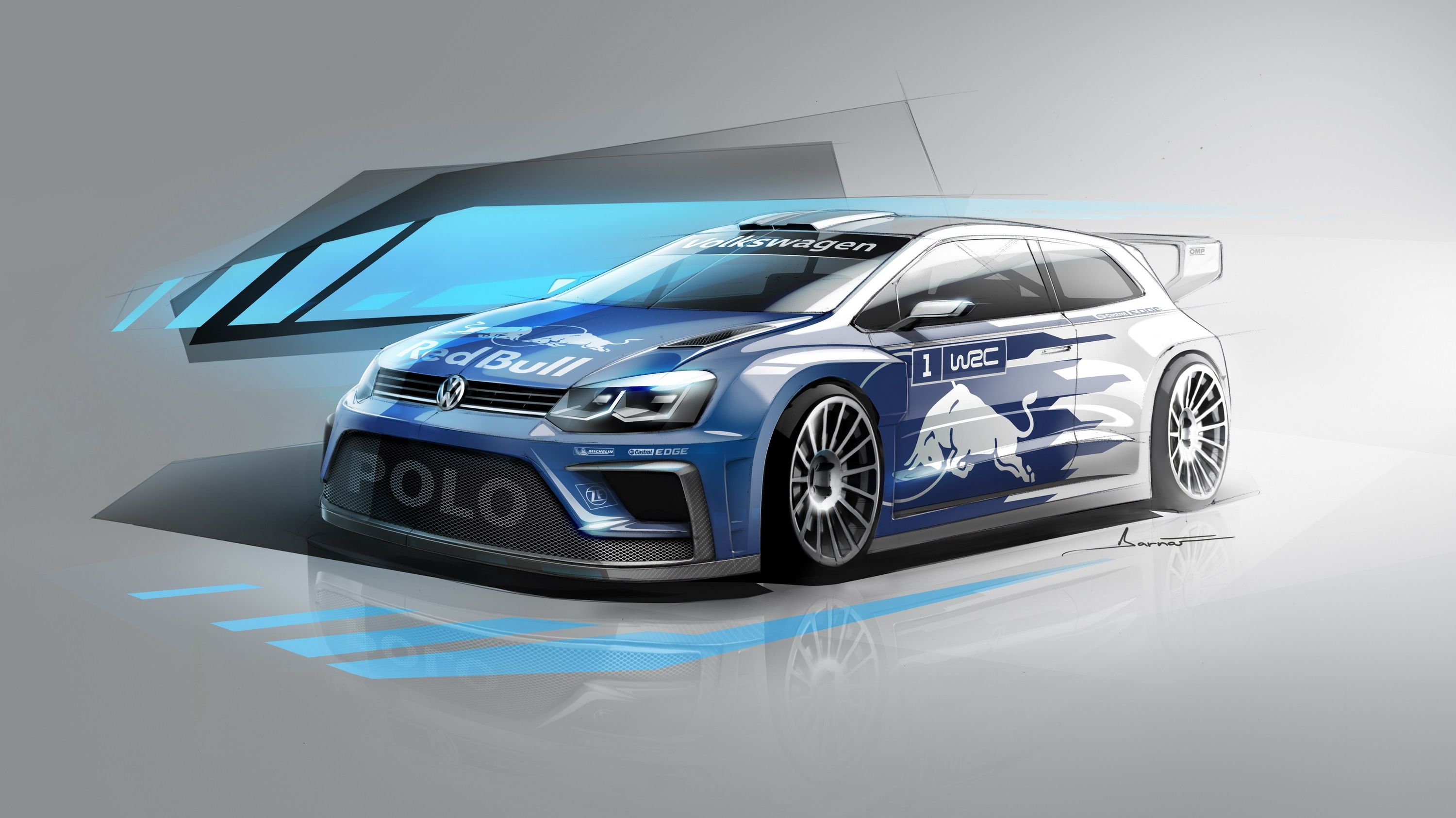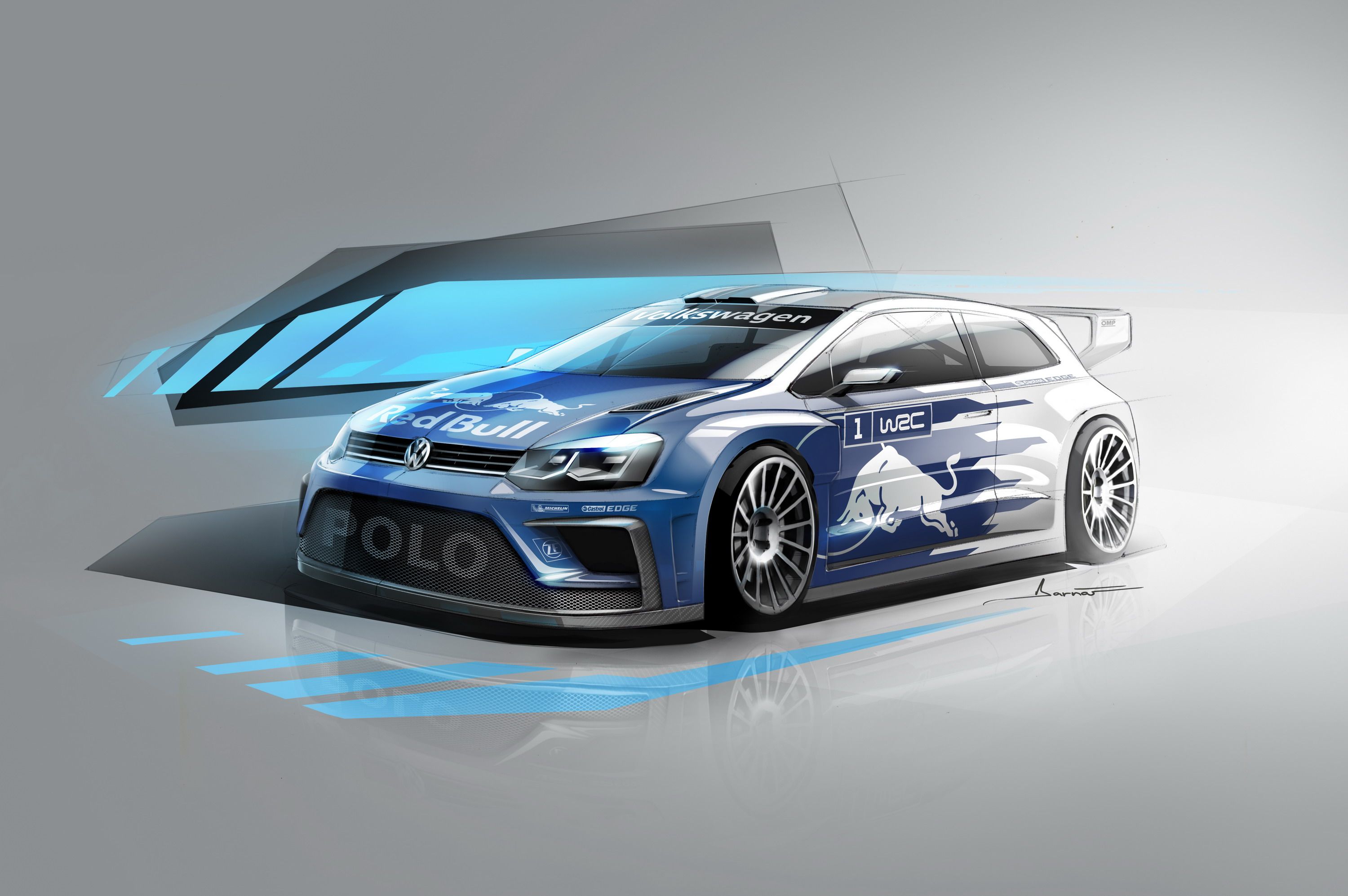Introduced for the 2013 racing season as Volkswagen'->ke94s first WRC-->ke523spec factory car since the 1990 Golf Rally G60, the Polo R WRC went on to dominate the sport by winning three back-to-back World Rally Championships through 2015. Having dominated each and every season since it returned to WRC, Volkswagen is gunning for more success starting 2017 with a new Polo-->ke322based racer.
Under development since summer 2015, when the FIA released the new regulations for the World Rally Car class, the 2017 Polo R WRC is previewed as a significant improvement over its predecessor. Just like any evolution out there, the new rally-->ke191spec compact is set to be lighter, more powerful and more aerodynamic. In other words, Ford->ke31 and Hyundai->ke201 have plenty of things to worry about for 2017 if they don't shape up over the next 12 months.
Details about the next-gen Polo R WRC are still very limited, and the actual car was only shown as a rendering, but Volkswagen provided just enough information for us to have a closer look at Wolfsburg's upcoming rally weapon. An unveiling is planned toward the end of 2016 with the official debut to take place at the Rally Monte Carlo in January 2017. Stay tuned for updates!
Continue reading to learn more about the 2017 Volkswagen Polo R WRC.
2017 Volkswagen Polo R WRC
- Make: Array
- Model: 2017 Volkswagen Polo R WRC
- Engine/Motor: inline-4
- Horsepower: 380
- [do not use] Vehicle Model: Array
Exterior
Note: 2015 Volkswagen Polo WRC pictured here.
Essentially a Volkswagen Polo GTi on steroids, the R WRC is set to continue as the most aggressive incarnation of a small hatch in 2017. Although Volkswagen released only a rendering of the car, we can see that the upcoming R WRC will remain familiar as a Polo. As usual, Volkswagen will keep key design features such as the slim front grille, the large headlamps, and most of the rear fascia and combine them with a massive body kit that widens the car and makes it significantly more aerodynamic than the hatch you can buy in showrooms.
For 2017, the Polo will get a even larger bumper grille and air intakes, a wider roof scoop, a bigger rear wing, and beefier fenders. The new aerodynamic kit will widen the car by about 50 millimeters (nearly two inches), which is a lot given that WRC racers usually don't get such modifications too often. Another hint that comes with the rendering and the livery depicted on the car is that Volkswagen will renew its partnership with Red Bull, its main sponsor since 2013. Given the brand's success in the sport, that's far from surprising.
Interior
Note: 2015 Volkswagen Polo WRC pictured here.
We know nothing of the R WRC's interior yet, but it's safe to assume it won't stray too far off the design we saw in the current race car. Look for the same no-nonsense design that retains very few parts from the original car. It should feature a pair of lightweight, bolstered seats to keep the driver and the co-pilot safe during those rough stages, while the multifunction, Alcantara-wrapped steering wheel will bring all the buttons and switches in front of the the man operating the race-spec hatch. The stock instrument cluster will be replaced by a small screen that will display the vital information. The production door panels will be replaced by carbon-fiber pieces, while the center console will be removed and the dashboard replaced with a lightweight shell that mimics the shape of the original element. An FIA-approved roll cage will provide the driver and his "guide" with the utmost safety in the event of a crash.
Note: 2015 Volkswagen Polo WRC pictured here.0}
Note: 2015 Volkswagen Polo WRC pictured here.
The revised aerodynamics will be backed by an updated drivetrain that will send more power to the wheels. Even though Volkswagen had nothing to say about engine displacement and design, it's safe to assume that based on the FIA's new regulation for the World Rally Championship that the Polo R WRC will use a new version of the turbocharged, 1.6-liter four-cylinder found in its predecessor. For 2017, Volkswagen is planning to use a 380-horsepower unit, which is a significant, 62-horsepower increase over the current car. The increase in performance was achieved by widening the air restrictor from 33 to 36 mm and the ability to use the electronic differential for the power transmission. Coupled with the fact that the curb weight has been reduced by 25 kg and aerodynamics have been improved, the new car should be able to accelerate quicker and improve its stage times on just about any WRC course in the race calendar. I'd dare say that the new Polo R WRC will be able to hit 62 mph from a standing start in less than 3.5 seconds. No word on what transmission will send all that oomph to the wheels, but Volkswagen should use a new six-speed gearbox.
Drivetrain
Note: 2015 Volkswagen Polo WRC pictured here.1}
In 2017, the manufacturer's championship will see five brands battle for supremacy. Volkswagen will be challenged by Hyundai, Ford, Citroen, and Toyota, the latter to return to WRC after a long absence. One of the Polo's most important competitors will be the Citroen DS3 WRC. Set to return in 2017 with an upgraded car, Citroen will be looking to recapture the success it had before Volkswagen joined the series. Nothing is known about the new DS3 WRC, so all we can do is wait for Citroen to spill the beans on its next-generation rally car.
Read our full review on the Citroen DS3 WRC here.
Ford Fiesta RS WRC
The Fiesta joined the World Rally Championship in 2011, when it replaced the successful Focus RS. Also powered by a turbocharged, 1.6-liter four-banger that mates to a six-speed sequential transmission, the Fiesta RS WRC is still struggling to make an impact in the championship. 2015 saw Ford finish only fourth in the manufacturer standings, while 2016 might bring the Blue Oval third place with Citroen not eligible to score points in the said category. An enhanced version is expected to arrive in 2017, but Ford no longer seems to have what it takes to deliver a championship-winning car. Hopefully the Brits will prove me wrong...
Read our full review on the Ford Fiesta RS WRC here.
Hyundai i20 WRC
Having joined the series in 2014, Hyundai is a new-comer to the championship. Developed by the company's N performance division, the i20 WRC is still struggling to adapt while the Germany-based crew behind it is looking for solutions to make it faster and more reliable. With a third-place finish in 2015 and trailing Volkswagen in the manufacturers' standing in the first part of 2016, the i20 WRC seems to get better and better. With a new-generation car underway for 2017, the Hyundai i20 appears to be the only car that can give the Polo R WRC a run for its money next season.
Read our full review on the Hyundai i20 WRC here.
Toyota Yaris WRC
After nearly two decades since it retired from the sport and with two championships to its name, Toyota is looking to return in 2017 with a race-spec version of the tiny Yaris. Designed and developed by Cologne-based Toyota Motorsport GmbH, the Yaris WRC will become Toyota's first factory rally car since the Corolla WRC, which was retired in 1999. I have strong doubts that the Yaris will make a notable impact in its first season -- let alone manage what Toyota did with the Celica in 1993 and 1994 -- but it's great to see that WRC will finally have more than four manufacturers on the starting grid.
Read our full review on the Toyota Yaris WRC here.
Conclusion
It's definitely way too early to draw a conclusion here, but based on the fact that the current Polo keeps winning races and it's likely for Volkswagen to win its fourth consecutive WRC championship, the next-gen car will continue to dominate WRC for the Wolfsburg-based crew unless Citroen, Hyundai, and Ford do something about it. The Germans seem to have found the perfect recipe for the Polo R WRC and, even though Hyundai appears to make important progress with each season that passes, Volkswagen will probably continue to win championships for at least a couple of years. It remains to be seen if this is the case or not, but for the sake of a spectacular 2017 season, I want to be wrong.




